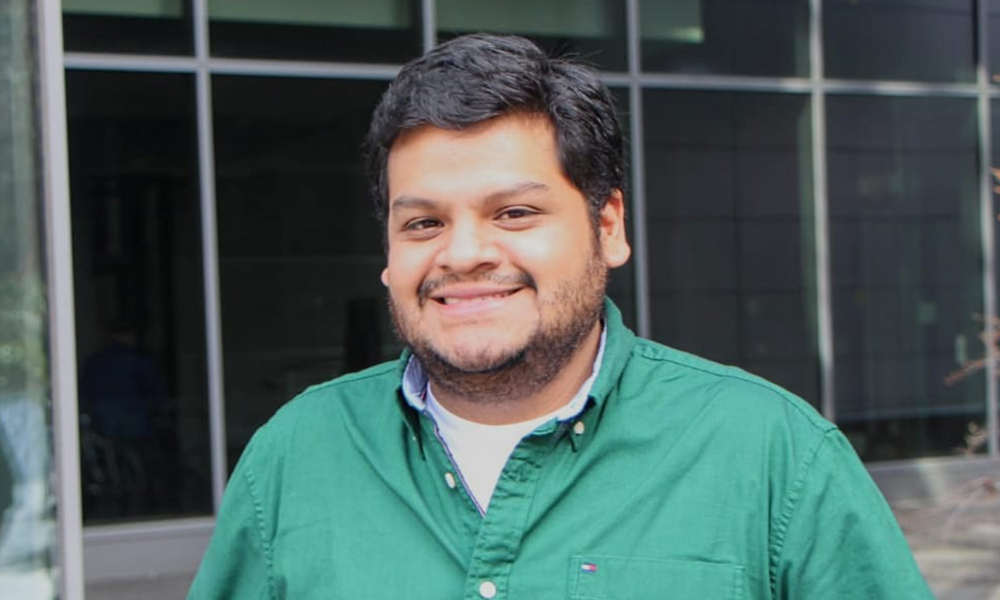Luis Hernandez-Nunez, postdoc in the Engert lab in MCB, is at the forefront of a new field he calls Systems neurocardiology, a combination of control theory, systems neuroscience, and cardiac science. And he hopes to bring in as many bright minds from around the world as he can, including from his home in Peru.
“When we think about congenital heart disease, we’re often looking at how the muscle develops. Very little is known about the neurons within the heart,” says Hernandez-Nunez. “I’m very excited to someday become faculty and mentor many generations of systems neurocardiologists. I think it’s going to be a very powerful field that’s just in early stages.”
Hernandez-Nunez became interested in control systems while training as an engineer at Universidad Nacional de Ingenieria, in Lima-Peru. While there, he was part of the team that designed the orientation control system for the first Peruvian satellite to be launched into space.
While studying control theory literature for the satellite project, he learned about controls in a completely different kind of system.
“I learned about these fascinating papers from Stan Leibler and John Doyle’s labs that studied how bacteria accomplished robust adaptation of its swimming behavior in chemical gradients,” he says. “I had always been thinking of control systems as implemented with electronic circuits, and then I learned that there’s this network of biological molecules that can accomplish even better performance, and they’re extremely tiny.”
Learning about this field sparked a new passion for Hernandez-Nunez, who still as an undergrad moved to Yale University to focus on studying biological controls systems. There, he used mathematical theory and modeling to look further into these bacterial swimming behavior controls.
This research path brought him to Harvard where he began studying controls in higher organisms, first in a PhD in the Samuel lab and eventually in his current postdoc.
“If bacteria can deal with biophysical constraints, then how do you go from that to animals? Animals have a lot of control systems—from motor control to temperature control to control of glucose,” he says. “And every organ has specific features that need to be controlled. So how is that implemented?”
During his Ph.D. with Aravinthan Samuel, Hernandez-Nunez discovered new molecules, cells, and circuits that help the larva of the fruit fly Drosophila melanogaster regulate body temperature. His Ph.D. work motivated him to take a step further for his postdoc and study how neural circuits control organ function.
He currently focuses on the neural circuits that control the heart of the zebrafish, a model organism that has organs homologous to humans and provides optical access to all neurons in its body. His work is being supported by a three-year grant from the Life Sciences Research Foundation and Additional Ventures, a philanthropy that focuses on shaping a healthier and more equitable world through science.
His past as an engineer has come in handy, as many of the questions he explores have never been asked—which means he needs to develop and build the tools to answer them.
“You essentially become the first person to be able to measure whatever thing the device that you made measures,” he says. “That means that tool now can be used by other scientists to study other questions that maybe they couldn’t before.”
“Luis has been the first and critical bridge that allowed for the coordinated efforts in my lab and that of Mark Fishman’s to study brain heart interactions in larval zebrafish,” says Florian Engert, Professor of Molecular and Cellular Biology. “He brought his phenomenal talent in quantitative approaches, computational modeling and experimental design to bear which was all critical to take this huge project off the ground. Furthermore, Luis turned out to have an extraordinary skill in recruiting, mentoring and organizing undergraduate students of various backgrounds and assembling them into a functional research team of excellent productivity that kindled a genuine passion for science.”
Hernandez Nunez’s interest in science grew out of a curiosity about the world and a love of observing the workings of nature. But a career as a scientist gelled well with his personal philosophy of how to best contribute to the betterment of the world.
“I wanted to do something that could have a lasting impact on society, something where I felt the contribution was clean and could not be undone,” he says. “If you think of politics, it’s very difficult to see what is actual progress versus what will be immediately undone when a new person takes the position. But science is a very unique way in which you can contribute, because once you make a scientific discovery, that is real. It’s a building block that stays there.”
Hernandez-Nunez’s lasting impact extends to the students he mentors as part of a program from the Simons Foundation Collaboration in the Global Brain that supports year-long internships for undergraduate students from historically marginalized communities. He is also working with his Peruvian colleagues from Harvard and MIT to create an internship program for undergraduates from Peru interested in conducting research in a neuroscience lab—an opportunity currently lacking in most Peruvian universities. The group is currently lining up sponsors and intends to launch the program in Fall ’23, with the hopes of expanding the offerings to other countries down the road.
“In Peru, there’s not a neuroscience concentration. So, undergrads interested in that have to choose biology, and there are almost no labs where they can do research in neuroscience. There’s a lot of talent that may be lost,” he says. “We want to create the opportunity for them to do internships where they can actually do research in neuroscience and explore that potential career path.”


